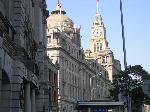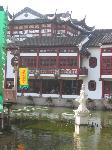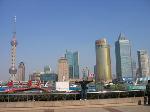- Getting around Lijiang. Dont stay in the Old Towns more than 2 days, there is nothing to do. KRISS Oct 9, 2013 05:46
- 2013 Beijing Temple Fair BENNYLAU Feb 26, 2013 03:29
- Malaysian traveling from KUL - LAX vis Shanghai PVG ZATI_DY Jan 3, 2013 20:15
<A> A Trip Through Time in Shanghai
- Views: 3065
- |Vote: 0 0
- |Add to Favorites
- |Recommend to Friends
SHANGHAI is a city always a-buzz. The fast paced walk of the millions of pedestrians, the honk of the automobiles and the ever present construction sites are a testament to its constant state of flux. One can never be too sure of what new skyline he’ll see upon flinging the curtains open each morning. The very air is tinged with excitement at the constant change that is Shanghai.
It is humbling to note Shanghai had beginnings as a simple marshland until the Song dynasty (AD 960-1126) when refugees from the Mongol and other nomad invasion brought a sudden influx of population. But, out of the ashes of the First Opium war in 1842 came signed foreign concessions first with the British, and eventually with American and French. Each would soon build their own neighborhood as they call Shanghai home and leave indelible marks of their presence in mythical Shanghai.
Shanghai’s superb location facing the Pacific and low government interference made it one of the busiest ports in the country and so begun its ongoing journey into the world market, trading anything from opium to arms and attracting ambitious entrepreneurs out to conquer this Paris of the East. Skyrocketing economic progress were also coupled with decadence, hedonism and an ever-widening rift between Shanghai high society and its workers. This became the seedbed of Chinese worker and student discontent that would blossom into the Chinese Cultural Revolution. Shanghai’s glory came to a shrieking halt.
By the 1990s with the dawn of a new more pragmatic regime, China seemed to remember this city’s former glory and would pour money into Shanghai’s rehabilitation. Two metro lines, a light railway system, a gleaming new airport in Pudong, and a rising economic development zone later, Shanghai’s star rises above the proverbial phoenix’s ashes poised to reclaim its former glory.
A walk down Henan Lu is like a walk down Shanghai’s history. Start where Henan Lu meets Nanjing Lu. Hailed as China’s number 1 commercial street, Nanjing Lu has been the haven for shopaholics and tourists alike with its display of neon lights and store fronts each offering tempting discounts. This landmark stretches for 3.4 miles and was once a flourishing business center in 19th century Shanghai. Partly pedestrianized to make way for the millions of people plying Nanjing Lu daily, metal sculptures are on display as shoppers dive in and out of the beckoning stores. Pop inside historic Peace Hotel where its 1920s Art Deco architecture is still evident. A walk down this shopping road is sure to bring in bargains and a good workout.
From here, work your way down the street and the timeline to Old Town Shanghai, where traditional China is still very much evident. Don’t be intimidated by the maze of streets and flea market style stalls; find your way to the Yu Gardens. The entrance blossoms open before your eyes in sharp contrast to the hanging laundry lines and the alleyways of Old Town. You’ll first see the stalls of the Yuyuan Bazaar where shrewd Chinese sellers are wont to overprice their goods to first time tourists. Prepare to roll up your sleeves and bargain to the last kuai. Don’t be afraid to shop around for the best price. After playing the tiring game of bargaining, walk through a portal back into 1500s China.
For 30 Renminbi (RMB), the entrance of the best preserved Southern Chinese style garden will open before your eyes. Green shingled roofs with sculptures depicting scenes from classical Chinese literature and pagodas abound as you walk the maze of the garden. Stone boats and rock gardens complement the koi-filled ponds. Stroll leisurely along zigzag walkways that Chinese belief says prevents evil spirits from crossing the domain. And, for a moment, close your eyes and imagine yourself in a different life – the life of a court official or lady of the house, calling this majestic garden your own.
After this long stroll in the past, it’s time once again to face the future like the ever-forward looking Shanghai, ready to meet the sunrise. Standing from the historic Bund that was once the hub of financial houses in the Far East lies Shanghai’s future, one can see the majestic skyline that is Pudong. The Chinese government’s commitment to developing this area in the 90s has not gone to naught.
Where Pudong was known in the past as simply the area east of the Huangpu River, and left unmarked on any map, it has expanded to seven times the size of the old city of Puxi. It now covers almost the whole eastern bank of Huangpu River. The first year of Pudong’s development was hailed as Shanghai’s “Year of Finance”. It is now home to 3,300 domestic and foreign financial institutions, 80% of the world top 50 banks have branches here.
High rises truly rise above their earthly stature here in Pudong with the unmistakable purple spheres of the Oriental Pearl TV tower and silhouette of Jin Mao Tower. The Jin Mao’s 88-floors houses various restaurants, food halls, bars and the world’s highest hotel above ground level, the Grand Hyatt. Taking cue from traditional Chinese architecture, its outline against the Oriental sky is reminiscent of a tiered pagoda, its proportions revolving around the number 8, symbolizing prosperity in Chinese culture. Jin Mao Tower is currently the tallest building in the People’s Republic of China but this may not be the case in 2007 with the coming of the Shanghai World Financial Center.
Shanghai is already well on its way to reincarnation – truly like the mythical phoenix, upon its rising comes a new life while remembering the fiery lives of its past. It is difficult not to experience occasional bouts of déjà vu and projections of the future all while walking down an expanse of Shanghai’s smooth cold pavement. There will surely be much more to see in Shanghai and, given the rate of development, things will only get better.






 Copyright © 1998-2026 All rights reserved.
Copyright © 1998-2026 All rights reserved.